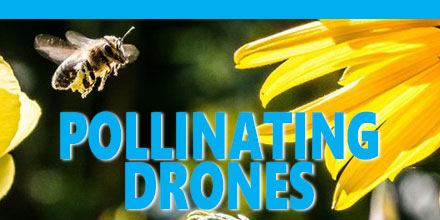
Pollinating Drones: Could Miniature UAVs save the World from Falling Bee Numbers? A number of scientists and drone developers are considering just that scenario.
For several years, scientist around the world have sounded the alarm over falling bee population numbers. Given their importance in the pollination of plants and crops, this is a cause for concern.
Scientists speculate that factors such as human activity and climate change have contributed to the steady decrease in pollinators.
But now researchers are proposing a radical new concept to tackle the troubling issue; tiny miniature drones as pollinators. Most of the world’s food supply comes from plants that require pollination. So, artificial pollinators may turn out to be an innovative and very important solution to securing it.
Swarms of tiny Drones to act as Pollinators
The United Nations Food and Agriculture Organization says that over 70% of the crops we rely on for food depend on insect pollination. Other studies have found almost 40% of pollinators like bees and butterflies are at risk of extinction.
To compound matters, as recently as last year, a massive chunk of commercial bee populations mysteriously died out. All this adds to concern about plant survival.
According to a team of scientists from the National Institute of Advanced Industrial Science and Technology in Japan this is where
drones as pollinators could help. The researchers, given the worrying collapse of global bee numbers, envision a future where drones help pollinate plant flowers.
As part of their research the scientists purchased an off the shelf UAV. The drone was outfitted with horsehair brush strips laced with ionic gel to mimic pollination by insects.
The goal was to pollinate a species of flowers using the souped up quad-copter as a bee replacement. The scientists soon discovered they could maneuver the hummingbird-sized drone to allow the bristles to gently collect pollen.
In this case, the drone successfully pollinated the wild Japanese lilies used in the trial. Thus, raising the prospect of swarms of drones working in fields to fertilize plants and crops i the future.
Ionic gel
An ionic gel turned out to be the key to the trial's success. The ionic gel is a sticky substance with a long-lasting , lift-and-stick-again quality. Researchers placed the gel on the drone's horsehair's brush strips.
Initially, the gel was developed by the research team’s lead chemist Eijiro Miyako for use on electrical components. However, it ended up finding its best-case use on the drone ‘bee’. For eight years, Miyako’s ionic gel had gone unused; the team was surprised at how well it retained its viscosity and resisted degradation.
This led to the researchers trialing the gel as their carrier for pollen and leading to the materials’ successful use on the artificial pollination drone.
Hope for Farmers and Environmentalists
The findings give hope to scientists and farmers across the world concerned about falling insect numbers and the possibility of crops failing should we fail to arrest the decline.
While it may seem impractical to have mechanical devices working as pollinators, the idea is not completely far-fetched. Advances in drone technology mean that it is possible to control a number of UAVs from one interface. In many cases it is possible to control them remotely through an autonomous program.
Currently, drones are available in a range of sizes. Advances towards miniature drones is not too far off either.
The results of the research could also have potential implications for both robotics as well as agriculture. The research team believes that through a combination of artificial intelligence and GPS data, these artificial pollinators could "learn" pollination paths.
Most crucial UAV development?
Innovative technology such as drones has always had a profound effect on the way we live and this may prove to be one of the most crucial UAV developments to date with regards to agriculture.
It is therefore possible that large swarms of drones deployed in the environment could eventually help to arrest the issues caused by falling bee populations.
Whether drones as pollinators are ever used to help secure the world’s food sources remains to be seen, but for worried farmers and environmentalists, it is a positive development.
 Pollinating Drones: Could Miniature UAVs save the World from Falling Bee Numbers? A number of scientists and drone developers are considering just that scenario.
For several years, scientist around the world have sounded the alarm over falling bee population numbers. Given their importance in the pollination of plants and crops, this is a cause for concern.
Scientists speculate that factors such as human activity and climate change have contributed to the steady decrease in pollinators.
But now researchers are proposing a radical new concept to tackle the troubling issue; tiny miniature drones as pollinators. Most of the world’s food supply comes from plants that require pollination. So, artificial pollinators may turn out to be an innovative and very important solution to securing it.
Pollinating Drones: Could Miniature UAVs save the World from Falling Bee Numbers? A number of scientists and drone developers are considering just that scenario.
For several years, scientist around the world have sounded the alarm over falling bee population numbers. Given their importance in the pollination of plants and crops, this is a cause for concern.
Scientists speculate that factors such as human activity and climate change have contributed to the steady decrease in pollinators.
But now researchers are proposing a radical new concept to tackle the troubling issue; tiny miniature drones as pollinators. Most of the world’s food supply comes from plants that require pollination. So, artificial pollinators may turn out to be an innovative and very important solution to securing it.

